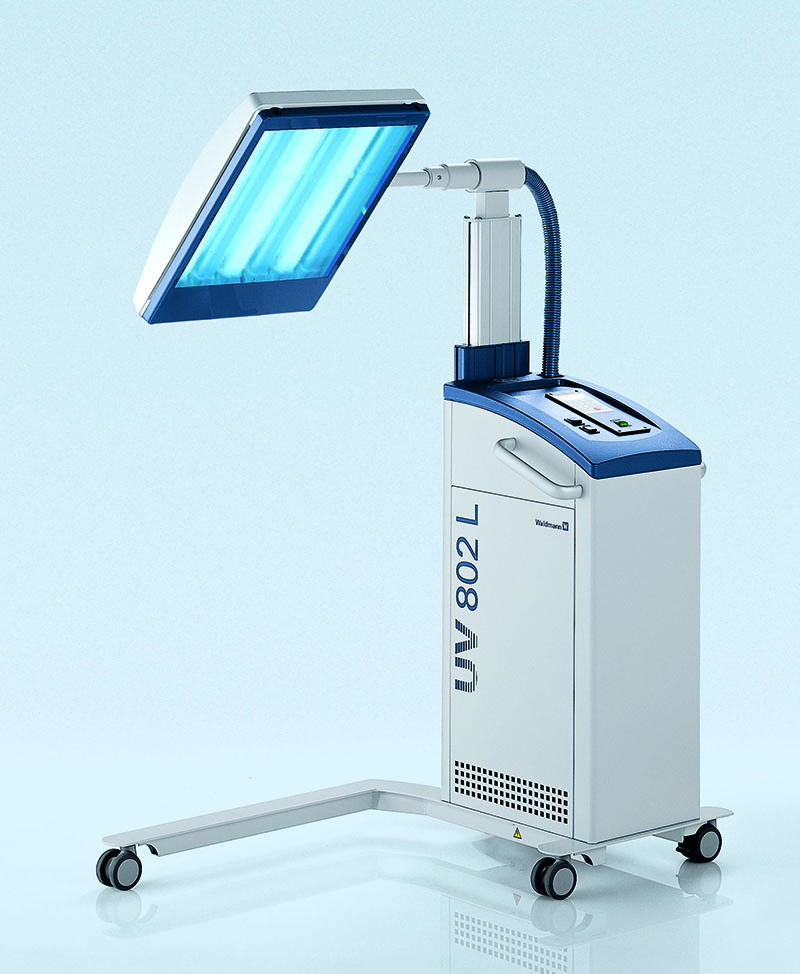Photopatch testing (PPT) - General information and methodology
What patients should be tested and what agents to test?
Primary indication should be dermatitis predominantly affecting exposed sites with or without a history of a sunscreen reaction and that PPT should also be considered in patients with chronic actinic dermatitis and any individual with a photosensitive eruption for which there is no obvious diagnosis. PPT should not be undertaken when the skin test area is active. The newly introduced European Photopatch Baseline Series EP-1000 is the series of choice supplemented by the additions in the European Photopatch Extended Series EPE-1000 as proposed by the Photopatch test taskforce group.2
Methodology of PPT and light source
The application area recommended is the mid upper back skin, avoiding 3-5 cm on either side of the vertebrae. Apply the agents using e.g. the IQ Ultra Chamber technique. Apply duplicate sets on left and right side of the back of the patient and leave the test units in place for either 24 or 48 h, after which both sets are removed. At this point, one set should be covered with an ultraviolet (UV) opaque material and the other irradiated with a calibrated metered broad-spectrum UVA source. The type of lamp used for testing should be noted as this may affect results.
Psoralen plus UVA fluorescent lamps are preferred because of their widespread availability, reproducible spectrum and beam uniformity. One choice of equipment is the UV-Therapy and Photodiagnosis system UV 802 L from Waldmann.
The UVA dose must be sufficient to trigger the photo allergy response without causing a false-positive or phototoxic response. The recommended dose is 5 J/cm2 for routine PPT.
Choice of ultraviolet dose
Timing of readings
Readings should be recorded using the International Contact Dermatitis Researc
h Group (ICDRG) scoring system with readings before irradiation, immediately after irradiation and 48 h after irradiation. Further readings at 72 and 96 h postirradiation are desirable to enable detection of crescendo or decrescendo scoring patterns suggesting allergic and non-allergic mechanisms, respectively. A positive reaction to a photohapten and light in the presence of negative 'contact' and 'irradiation' controls strongly supports a photoallergic mechanism, particularly where a strengthening response over the reading time points is recorded. At the same time, it is important to recognize that non-irradiated test site results due to irritancy/allergy or photoaggravation (at the irradiated site) of an irritant/allergic reaction, phototoxicity and awareness of the possibility of a technical error, should all be identified and recorded.
Please visit Waldmans for more information
Please visit Waldmans for more information

Relevance of readings
- It is important to record the relevance of the result using a system such as COADEX. This classifies clinical relevance of positive allergic patch test reactions as:
- current relevance (the patient has been exposed to a hapten during current episode of dermatitis and improves when the exposure ceases);
- old or past relevance (past episode of dermatitis from exposure to haptens);
- actively sensitized [patient presents with a sensitization (late) reaction];
- relevance not known (not sure if exposure is current or old);
- cross-reaction (the positive test is due to cross-reaction with another hapten);
- exposed (a history of exposure but not resulting in dermatitis from that exposure or no history of exposure but a definite positive allergic patch test).
(C = current; 0= old; A = actively sensitized; D = do not know; EX = exposed).
Testing the ultraviolet A photosensitive or immunosuppressed patient
When photopatch testing a patient who has an abnormal UVA sensitivity, it is advisable to establish the UVA minimal erythema dose (MED) prior to PPT. Although there is a lack of recommended dose series data, it is important to test up to and including 5 J/cm2 with the same UVA source as used for PPT. If the MED detected at 24 h is less than the lowest dose, it is advisable to use 50% of this value with an awareness of the increased possibility of photoaggravated irritant and contact reactions. Although concomitant systemic or topical immunosuppression/ antihistaminic action may result in a false-negative result, a positive response will be valid. In the absence of published data on the duration/degree of immunosuppressive effect, it is recommended when clinically feasible, that such therapy should be stopped for at least 2 weeks prior to PPT investigation.
References
1. Photopatch testing: a consensus methodology for Europe. The European Taskforce for Photopatch Testing: Members of the panel: D.P. Bruynzeel, the Netherlands; J. Ferguson, Scotland, UK;K. Andersen, Denmark; M. Goncalo, Portugal; John English, UK; A. Goossens, Belgium; E. Holzle, Germany; S.H. Ibbotson, Scotland, UK; M. Lecha, Spain; P. Lehmann, Germany; F. Leonard, France; Harry Moseley, Scotland, UK; P. Pigatto, Italy; A. Tanew, Austria. JEADV (2004) 18, 679-682.
2. PHOTOPATCH TESTING: Recommendations for a European photopatch test baseline series. Contact Dermatitis (2013), accepted for publication. Anna Bonevalle, Derk P Bruynzeel, Ana Giménez-Arnau, An Goossens, Alastair Kerr, Mario Lecha, Norbert Neumann, Bo Niklasson, Paolo Pigatto, Lesley Rhodes, Thomas Rustemeyer, Robert Sarkany, Pierre Thomas, Mark Wilkinson.
2. PHOTOPATCH TESTING: Recommendations for a European photopatch test baseline series. Contact Dermatitis (2013), accepted for publication. Anna Bonevalle, Derk P Bruynzeel, Ana Giménez-Arnau, An Goossens, Alastair Kerr, Mario Lecha, Norbert Neumann, Bo Niklasson, Paolo Pigatto, Lesley Rhodes, Thomas Rustemeyer, Robert Sarkany, Pierre Thomas, Mark Wilkinson.

